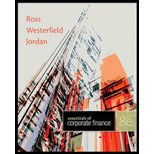
Essentials of Corporate Finance
8th Edition
ISBN: 9780078034756
Author: Stephen A. Ross, Randolph W. Westerfield, Bradford D. Jordan
Publisher: MCGRAW-HILL HIGHER EDUCATION
expand_more
expand_more
format_list_bulleted
Question
Chapter 13.7, Problem 13.7ACQ
Summary Introduction
To discuss: Whether the Corporations of Country U highly depend on debt financing
Introduction:
The debt financing denotes rising of money by the firm through the sale of bills, notes, or bonds to the institutional investors or individual.
Expert Solution & Answer
Want to see the full answer?
Check out a sample textbook solution
Students have asked these similar questions
Need abs
Need answer n
Dear tutor soln
Chapter 13 Solutions
Essentials of Corporate Finance
Ch. 13.1 - What is the relationship between the WACC and the...Ch. 13.1 - Prob. 13.1BCQCh. 13.2 - Prob. 13.2ACQCh. 13.2 - Prob. 13.2BCQCh. 13.2 - Prob. 13.2CCQCh. 13.3 - What does MM Proposition I state?Ch. 13.3 - Prob. 13.3BCQCh. 13.3 - Prob. 13.3CCQCh. 13.4 - Prob. 13.4ACQCh. 13.4 - Prob. 13.4BCQ
Ch. 13.5 - Prob. 13.5ACQCh. 13.5 - Prob. 13.5BCQCh. 13.6 - Can you describe the tradeoff that defines the...Ch. 13.6 - What are the important factors in making capital...Ch. 13.7 - Prob. 13.7ACQCh. 13.7 - Prob. 13.7BCQCh. 13.8 - What is the APR (in connection with bankruptcy...Ch. 13.8 - What is the difference between liquidation and...Ch. 13 - Prob. 13.3CCh. 13 - Prob. 13.4CCh. 13 - Prob. 13.5CCh. 13 - Section 13.6The static theory of capital structure...Ch. 13 - Prob. 13.8CCh. 13 - Business Risk versus Financial Risk. Explain what...Ch. 13 - Prob. 2CTCRCh. 13 - Prob. 3CTCRCh. 13 - Prob. 4CTCRCh. 13 - Prob. 5CTCRCh. 13 - Prob. 6CTCRCh. 13 - Prob. 7CTCRCh. 13 - Prob. 8CTCRCh. 13 - Prob. 9CTCRCh. 13 - Prob. 10CTCRCh. 13 - Prob. 1QPCh. 13 - Prob. 2QPCh. 13 - Prob. 3QPCh. 13 - Prob. 4QPCh. 13 - Prob. 5QPCh. 13 - Prob. 6QPCh. 13 - Prob. 7QPCh. 13 - Prob. 8QPCh. 13 - Prob. 9QPCh. 13 - Prob. 10QPCh. 13 - Prob. 11QPCh. 13 - Prob. 12QPCh. 13 - Prob. 13QPCh. 13 - Prob. 14QPCh. 13 - Prob. 15QPCh. 13 - Prob. 16QPCh. 13 - Prob. 17QPCh. 13 - Prob. 18QPCh. 13 - Prob. 19QPCh. 13 - Business and Financial Risk. Assume a firms debt...Ch. 13 - Prob. 1CCCh. 13 - Prob. 2CCCh. 13 - Stephenson Real Estate Recapitalization Stephenson...Ch. 13 - Prob. 4CCCh. 13 - Prob. 5CC
Knowledge Booster
Learn more about
Need a deep-dive on the concept behind this application? Look no further. Learn more about this topic, finance and related others by exploring similar questions and additional content below.Similar questions
- Which of the following is not an investment grade credit rating?* BB+ BBB+ BBB BBB-arrow_forwardCompany A has a capital structure of $80M debt and $20M equity. This year, the company reported a net income of $17M. What is Company A's return on equity?* 117.6% 21.3% 85.0% 28.3%arrow_forward12. Which of the following is the formula to calculate cost of capital?* Total assets/Net debt x Cost of debt + Total assets/Equity x Cost of equity Net debt/Equity x Cost of debt + Equity/Net debt x Cost of equity Net debt x Cost of debt + Equity x Cost of equity Net debt/Total assets x Cost of debt + Equity/Total assets x Cost of equity .arrow_forward
- no ai .What is the enterprise value of a business?* The market value of equity of the business The book value of equity of the business The entire value of the business without giving consideration to its capital structure The entire value of the business considering its capital structurearrow_forward10. The concept of time value of money is that* The cash flows that occur earlier are more valuable than cash flows that occur later The cash flows that occur earlier are less valuable than cash flows that occur later The longer the time cash flows are invested, the more valuable they are in the future The future value of cash flows are always higher than the present value of the cash flows .arrow_forward9. Which of the following is true when a bond is trading at a discount?* Coupon Rate > Current Yield > Yield to Maturity Coupon Rate < Current Yield < Yield to Maturity Coupon Rate = Current Yield = Yield to Maturity Coupon Rate < Current Yield = Yield to Maturity.arrow_forward
arrow_back_ios
SEE MORE QUESTIONS
arrow_forward_ios
Recommended textbooks for you
 EBK CONTEMPORARY FINANCIAL MANAGEMENTFinanceISBN:9781337514835Author:MOYERPublisher:CENGAGE LEARNING - CONSIGNMENTBusiness Its Legal Ethical & Global EnvironmentAccountingISBN:9781305224414Author:JENNINGSPublisher:Cengage
EBK CONTEMPORARY FINANCIAL MANAGEMENTFinanceISBN:9781337514835Author:MOYERPublisher:CENGAGE LEARNING - CONSIGNMENTBusiness Its Legal Ethical & Global EnvironmentAccountingISBN:9781305224414Author:JENNINGSPublisher:Cengage Intermediate Accounting: Reporting And AnalysisAccountingISBN:9781337788281Author:James M. Wahlen, Jefferson P. Jones, Donald PagachPublisher:Cengage Learning
Intermediate Accounting: Reporting And AnalysisAccountingISBN:9781337788281Author:James M. Wahlen, Jefferson P. Jones, Donald PagachPublisher:Cengage Learning

EBK CONTEMPORARY FINANCIAL MANAGEMENT
Finance
ISBN:9781337514835
Author:MOYER
Publisher:CENGAGE LEARNING - CONSIGNMENT

Business Its Legal Ethical & Global Environment
Accounting
ISBN:9781305224414
Author:JENNINGS
Publisher:Cengage


Intermediate Accounting: Reporting And Analysis
Accounting
ISBN:9781337788281
Author:James M. Wahlen, Jefferson P. Jones, Donald Pagach
Publisher:Cengage Learning

Bonds Explained for Beginners | Bond Types 101; Author: TommyBryson;https://www.youtube.com/watch?v=yuKmHTgqZ5o;License: Standard Youtube License